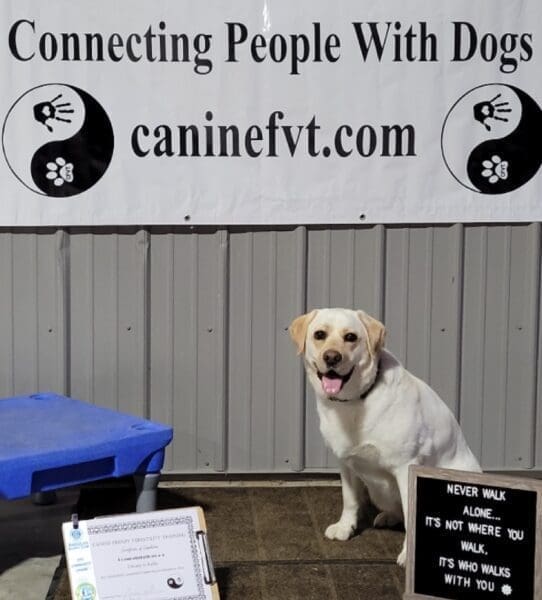For new dog owners, or those looking to take the human-canine relationship and interaction to the next level, there’s nothing quite luck a training class.
Whether you just want to ensure your newly adopted or rescued pooch is able to socialize properly in company, or you’re thinking about entering tricks, drills, and skills competitions, or maybe even a dog show, classes can be a good first step.
But what’s a good place to start? And what should you look out for?
“The first thing you want to see is if they have certified evaluators,” said Pamela Sisler with Canine Frenzy Versatility Training. “You want to make sure they take all breeds, including mix breeds, and also dogs who may have aggression problems.
“If your dog has aggression issues, you’ll want to mention that up front, and also make sure they are still willing to work with you.”
Sisler and the other trainers/evaluators at Canine Frenzy offer different classes throughout the year, each running approximately six weeks in length.
They offer Star Puppy, and Canine Good Citizen (CGC) classes, along with the more specific Advanced Canine Good Citizen (CGCA) and Urban Canine Good Citizen (CGCU), along with trick and fit dogs’ classes. All CFVT instructors are certified.
The type of class you and your dog should attend is really dependent on what you want out of the class.
Do you want your dog to be a well-mannered pet, a house dog if you will, or do you want them to be a show dog at an advanced level,” Sisler asked. “We find out what you want out of your experience and suggest what classes to take.”
Sisler said a lot of clients will come primarily wanting just a well-mannered dog. But upon going through the course, seeing how much fun they are having and how well their dog is performing, they want to continue with the training and increase the difficulty and skill level.
“Once people start, sometimes they really see what all we offer and they want to participate in those kinds of classes,” Sisler said. “They really enjoy it and want to go onto show-type training.”

Working With Aggression
As Sisler said, if you are wanting to work with your dog that has aggression issues, this is the place. And often time, Sisler and her co-evaluators will discover the dog itself isn’t actually aggressive. There are elements that are leading to certain behaviors which are usually easily correctable.
“Our trainers can go out to the homes and can debunk problems,” Sisler said. “Usually, it’s a communication problem as opposed to just an aggressive dog.”
That’s why CFVT trainers like to know ahead of time about dog aggression. Those dogs can be worked with in a private class, one-on-one with the trainer and owners. This cuts down on the distractions of other owners and dogs, enabling the pooch in question to focus and make considerable progress.
“The private classes start off at four weeks, and then we can move into more of a group class as they progress,” Sisler said. “Dogs that do private classes can excel very fast because they don’t have the additional stimuli around them. They are able to focus and learn the commands.”
Sisler has seen many a dog labeled as “aggressive” turn into a well-mannered pet, and even go further into the advanced training.
On the opposite end of the spectrum, people wanting to get their already well-mannered canines into potentially a therapy dog type roll can also benefit from CFVT courses.
Therapy dogs are extremely beneficial say for a child suffering from anxiety. They are able to pet the dog and lesson their anxiety symptoms. The dog becomes a friend, free from judgment, and is a great boost to the suffering youth. They also can make the rounds at local nursing homes, giving the residents something to look forward to during their visits.
Finding out if your dog has the right temperament is the first step in this process. Sisler offers temperament test, and coupled with the CGC test, it helps form a good baseline of a dog’s capability to serve in said capacity.
“The temperament and CGC tests help form a good baseline,” she said. “The CGC helps dogs be ready to be out in public, learning the basic commands with distance and duration. It helps them get ready for everything they may run into or encounter out in public.”
Classes Fill Fast
Sisler noted there are two trainers per class at both the Marietta and St. Clairsville (Belmont) locations. That allows for between 8-10 dogs, plus handlers, in the class.
“We like to keep them smaller, which allows them to get more out of the class and allow for more 1-on-1 time and attention.”
Sisler explained that when she hears from prospective clients, there is usually already an issue that the owner would like to see corrected in their young or newly rescued dog. Sometimes it’s housebreaking, or nipping and biting, maybe even overly excited jumping when a new person comes to visit the home.
There’s a number of reasons why people call to join a class, but the end result is a better communication base and relationship between human and canine.
Given that the class sizes are smile, they tend to fill up quickly. Sisler recommends getting in touch with CFVT quickly and, if the present class is already filled, you can get on the waiting list for the next one which will begin six weeks afterward.
Sisler began her career in training when she was in 4-H, showing for both 4-H and the American Kennel Club. She trained in the AKC as an adult as well. For the longest time, she worked primarily with aggressive dogs.
About four years ago, she headed up the Pet Pals program with the Monroe Country 4-H. But as requests for dog lessons began to grow, she started working more on the obedience side. Canine Frenzy Versatility Training was born from there.




